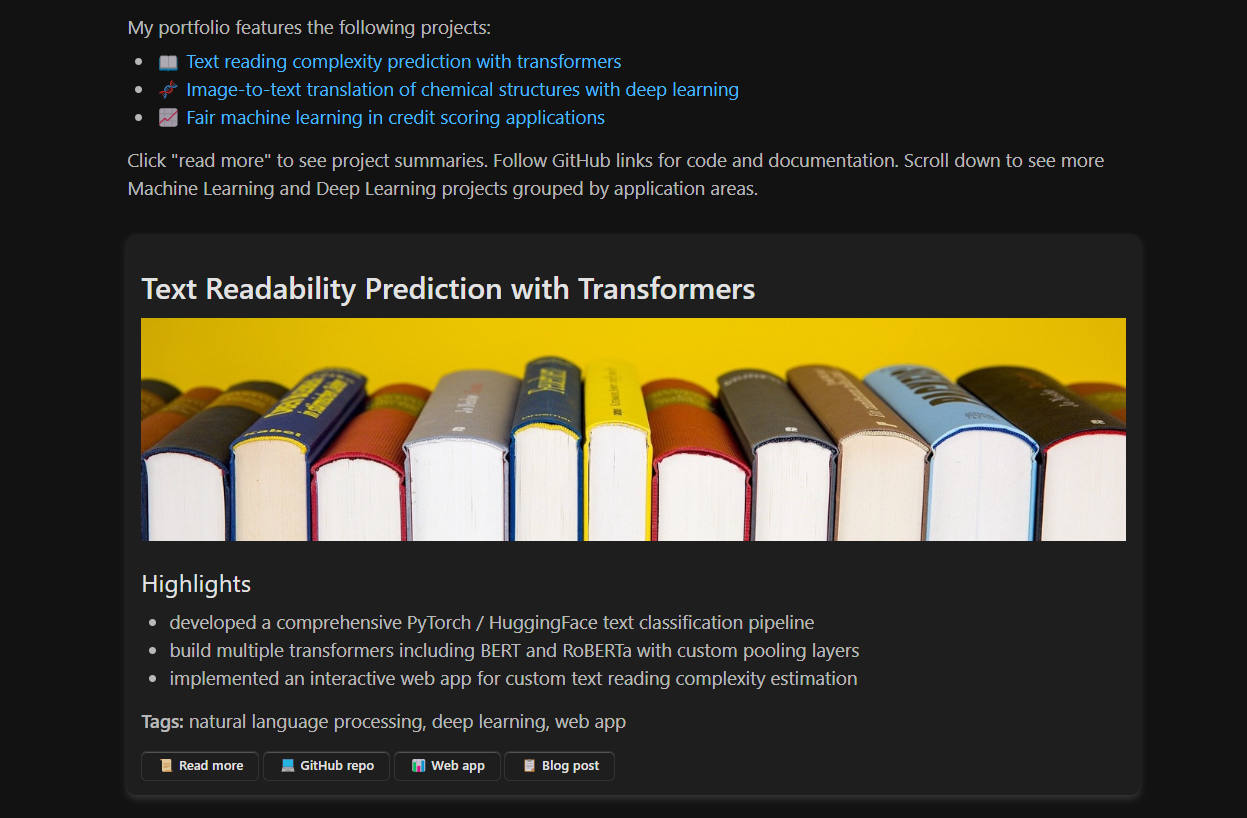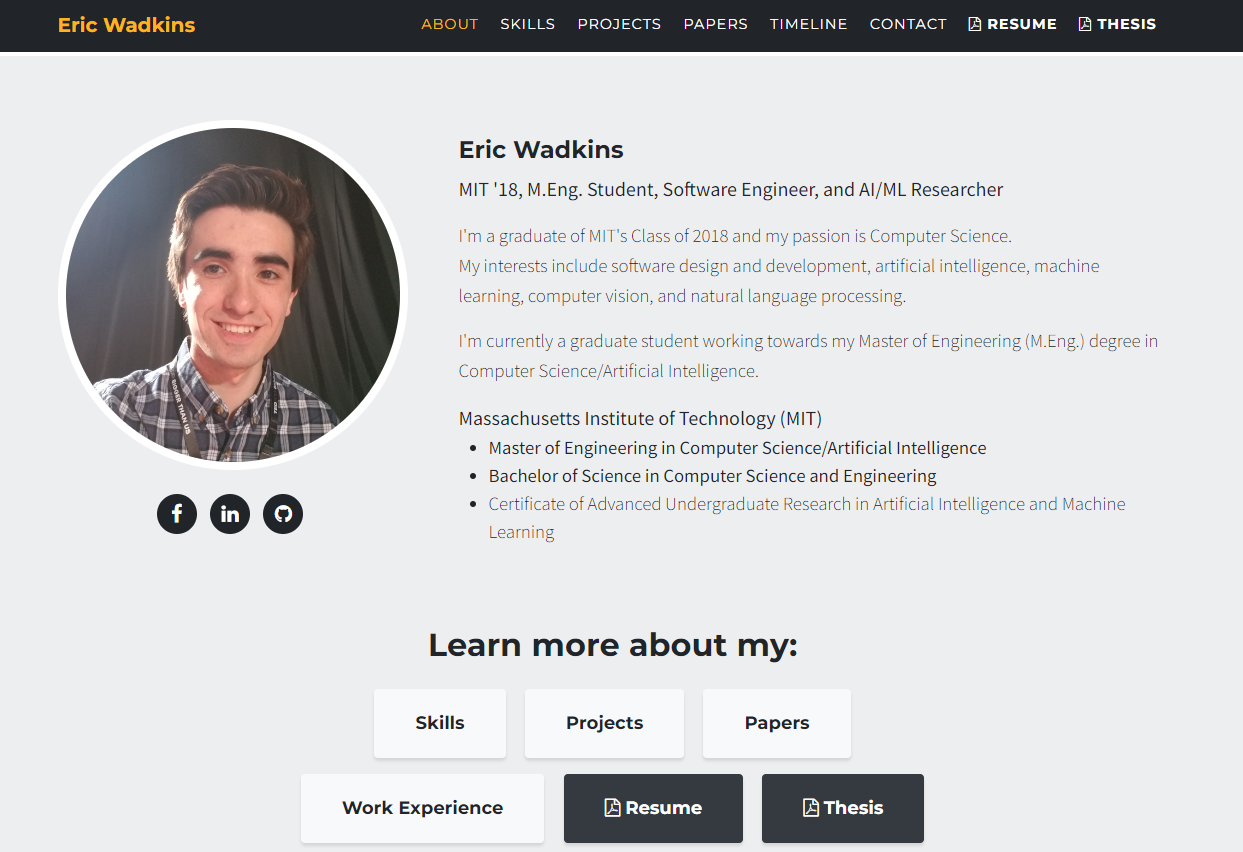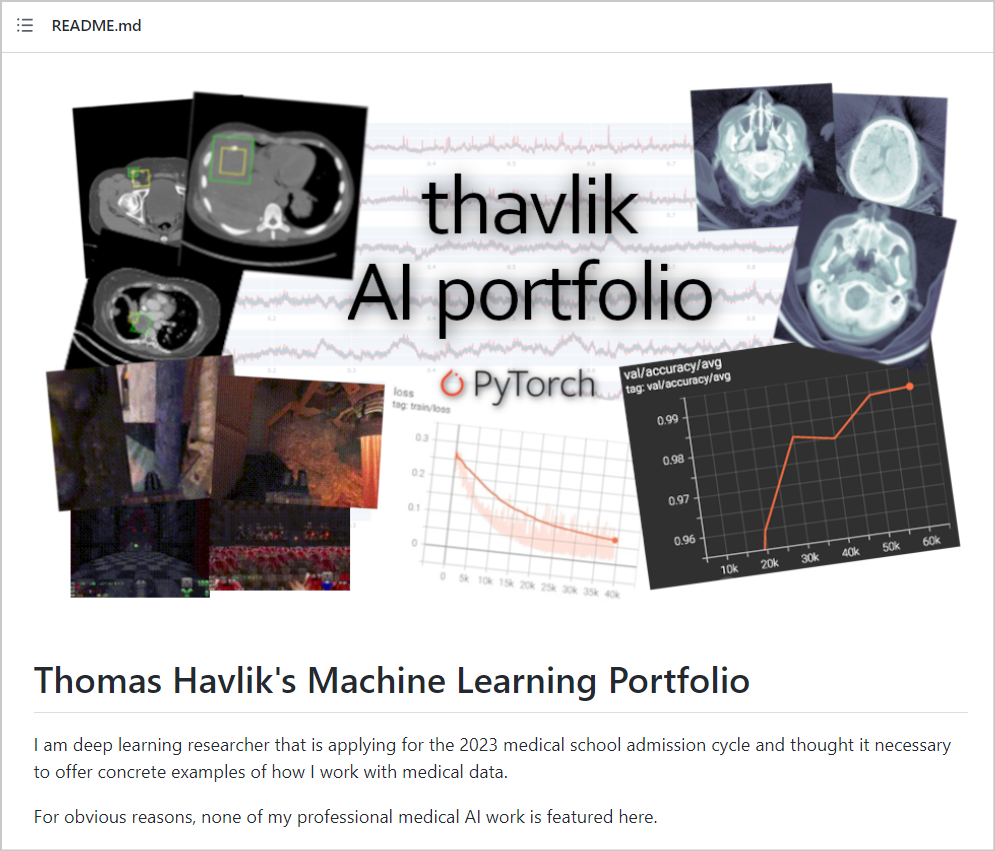How To Build a Machine Learning Portfolio (+ Examples)

In this article
- What Is a Machine Learning Portfolio?
- Why Do You Need a Machine Learning Portfolio?
- Elements of a Winning Machine Learning Portfolio (Format and Content)
- Tips for Building an Effective Machine Learning Portfolio
- Final Checklist for Your Machine Learning Portfolio
- Machine Learning Portfolio Examples
- How To Present a Machine Learning Portfolio
- What Do Recruiters Look for in a Machine Learning Portfolio?
- Machine Learning Portfolio FAQs
The applications of machine learning are numerous, and the field is only growing. From self-driving cars to early cancer detection, machine learning’s capacity to learn new information based on existing patterns or data is changing the way that we live.
Because of this, machine learning engineers are in demand. And while educational requirements and experience are important, most hiring managers will tell you that an application’s portfolio is one of the most important parts of their package.
So if you’re looking to join this exciting field, and want to build out a compelling portfolio, then you’re in the right place. Below, we’ll show you how to build a machine learning portfolio, and offer up some winning examples, so that you’re one step closer to landing the machine learning job of your dreams.
What Is a Machine Learning Portfolio?
A machine learning portfolio is a collection of personal projects and learning experiences demonstrating your ability to apply machine learning principles to real-world problems. It also gives employers an idea of what you’re capable of in terms of implementation and design.
Why Do You Need a Machine Learning Portfolio?
Machine learning is a highly technical field, and it can be challenging to show off your skills in a way that’s easy for an employer to understand. A machine learning portfolio is a perfect solution for this problem because it demonstrates your expertise and experience in one place.
Elements of a Winning Machine Learning Portfolio (Format and Content)

When building a machine learning portfolio, it’s important to remember that you’re not just building a project—you’re demonstrating your reputation. Your portfolio is your calling card and should reflect everything you want potential employers or clients to know about you: your skills, interests, and experience.
In this section, we’ll discuss the elements of a winning machine learning portfolio.
A Short Description Highlighting You, Your Work, Your Domain Expertise, and Your Related Interests
Your short description should be no longer than two paragraphs. First, introduce yourself, including your name and details about your background. Then describe your work experience in machine learning, especially recently completed personal projects. Finally, mention related interests or passions.
Skillsets and Tools You Know
This is where you should list all of the languages and frameworks you know well enough to use in production environments. Mention all the skills you have acquired throughout your experience using tools such as TensorFlow, Scikit-learn, or Keras. You will also want to include any machine learning algorithms you have mastered over time and use regularly.
Your Best Projects
Your portfolio should include links to some of your best projects so clients can see exactly what work you do best.
Key Topics To Include for Each Project
Here are the details you should include for each of your projects:
General Details
The general details of the machine learning project should be included in the first part of your post. This will help potential employers understand what you’re trying to achieve and why it’s important.
Tools and Methods Used
You should include a short list of tools you used for this project and any methods or processes you followed. This gives readers a better idea of how you built your project and why you chose those particular tools.
Results
Highlight the results you got from your model or system and why you think this happened. Were there any outliers or anomalies in your data that affected the results? Can you explain why these occurred, even if they weren’t expected?
Learnings and Takeaways
Finally, you’ll want to leave the readers with some takeaways. Did anything surprising happen during this process that changed how you think about machine learning at large? Did any personal growth occur as a result of working on this project?
Achievements and Social Proof
Make sure to include any relevant achievements or awards from previous jobs. This could be anything from a list of awards you’ve won, data science courses you completed, a list of companies you’ve worked with, or testimonials from previous managers, colleagues, and friends.
GitHub Profile Link
If you’re looking for a job in machine learning and still need to gain experience, this might be the most important part of your portfolio. The only thing worse than having zero experience is having no way to show off your skills when companies look at your resume. An excellent way to avoid this problem is to show off some projects on GitHub (and then link them from there).
An Easy Way To Reach You
If an employer wants more information about one of your projects, having a straightforward way for them to reach you is essential. Include your email address, phone number, and relevant social media handles.
Add-Ons (as Needed)
Here are other topics worth mentioning that can further impress potential employers.
Volunteer Work
You want to show that you can be a team player and work on projects that are bigger than yourself. If you don’t have any volunteering experience yet, ask around. Most companies have a volunteer program that accepts applications from people who want to help with specific machine learning projects.
Participation in Hackathons and Competitions
Another great way to show off your skills is through competitions like hackathons or coding competitions. These will allow you to work with a team, which employers look for in potential employees.
Reports and Articles
If you’ve written any reports or articles related to machine learning, ensure they’re included in your portfolio. It’s good practice to publish research results online so that other researchers can see what kind of work you’ve done and how it compares with other researchers’ findings on similar topics.
Any Conferences Where You’ve Presented Your Work
If you’ve ever presented your work at a conference, include the details in your portfolio. This is considered an outstanding achievement and can give you a massive advantage over other candidates.
Tips for Building an Effective Machine Learning Portfolio

Here are some of the best ways to build a compelling portfolio that showcases your machine learning skills and helps you land the job you want.
How To Make a Great First Impression
Here are six tips on how to make your portfolio stand out from the crowd:
Show, Don’t Tell
You can’t just tell someone that you have some knowledge of machine learning—you have to show them. The best way to go about this is by providing examples and demonstrations of your work rather than just writing about your projects. Showcase the original code, synthesize the techniques you used, and quantify your results.
Ensure Your Portfolio Loads Quickly and Is Easily Navigable
Your portfolio should load quickly and be easy to navigate so the hiring manager can get the complete picture of what you’ve been working on without spending too much time clicking around.
Try Adding a Separate Page or Section for Each Project To Go Into Better Detail
Adding separate pages for each project lets the hiring manager get a more in-depth look at what you’ve accomplished with each project and keeps your portfolio more organized and clean.
Always Keep Your Portfolio Up to Date
It’s essential to always keep your portfolio up to date because machine learning is an ever-changing field, and you need to keep track of the new technology. Not only does this help others see how much progress you’re making, but it also shows them that you’re dedicated to your work.
Link to Your GitHub and LinkedIn Profiles
If you have projects hosted on GitHub or other similar sites, make sure there’s a link somewhere on your website or blog so employers can easily find them. It’s also helpful if you include links to any articles about these projects, so hiring managers can read more about what went into making the project successful.
Aesthetics and Readability Matter
You want people to navigate through your content easily, so make sure your portfolio is clearly laid out and easy to read.
Seek Feedback From a Mentor Before Publishing Your Portfolio
Before publishing a machine learning portfolio, seek feedback from a mentor or peer. Not only will this help you refine your message, but it will also provide valuable insight into how others perceive you and your work.
Get To Know Other Data Science Students
Bryan Dickinson
Senior Marketing Analyst at REI
Jonathan King
Sr. Healthcare Analyst at IBM
Ginny Zhu
Data Science Intern at Novartis
What To Avoid
You’ve got many options for what you can showcase in your portfolio, but what should you avoid?
Don’t Copy Someone Else’s Portfolio
It’s tempting to look at another person’s portfolio and think, “I want a portfolio just like that.” But don’t copy someone else’s work. You want to show off the best of your abilities, so make sure your portfolio is yours uniquely.
Show Your Best Work
If there are projects that you’re not particularly proud of, consider leaving them out of your portfolio entirely. When building out your portfolio, including everything that might impress hiring managers may be tempting. However, only focus on what you think is essential and make sure that’s reflected in what you include on your resume or online application form.
Final Checklist for Your Machine Learning Portfolio

To ensure your portfolio is as strong as possible, we’ve put together a checklist of things to consider before sending off your application.
Are These Your Best Machine Learning Projects?
The first question to ask yourself is whether or not your portfolio is your very best work. If it’s not, then you need to go back and refine it before you send it out.
Does Your Portfolio Showcase a Well-Rounded Set of Machine-Learning Skills?
If you have time, look through your past projects and make sure that they showcase a well-rounded set of machine-learning skills. If there are gaps in what you’ve done, try to fill them in by learning new algorithms or programming languages.
Do the Projects in Your Machine Learning Portfolio Match the Type of Job You’re Applying For?
The next thing to consider is whether the projects in your portfolio match the job you’re applying for. Make sure that any particular skills you want to highlight are present in at least one of the projects included in your portfolio.
Is Your Portfolio to the Point, Accessible, Readable, and Complete?
Make sure your portfolio is complete before sending it off. Ask yourself these questions:
- Does it have a clear goal?
- Does it include a summary of your work?
- Does it provide a brief description of the field you worked in and the problem you solved?
- Does it discuss the approach you took?
- Is there a section on results that includes what you did, how well it worked, and any lessons learned from your efforts?
Machine Learning Portfolio Examples
Here are three examples of machine learning portfolios to inspire you.
Machine Learning Portfolio Example #1 – Nikita Kozodoi

What We Like About This Portfolio
Nikita’s portfolio is an excellent example of how to make your content easy to read and understand.
From the start, he gives an overview of what you can find in his portfolio in under two sentences. He also links to GitHub, his CV, and his about page, so you can learn more about him without going through several pages of text.
He then goes into more detail about each project, giving a quick summary and then giving more information as needed. This makes it easy for the reader to get an idea of what each project does before reading about it in detail. There is always a link to the project on GitHub, which makes it easy for someone who wants to try out the code or extend it in any way.
Machine Learning Portfolio Example #2 – Eric Wadkins

What We Like About This Portfolio
Eric’s machine learning portfolio greatly reflects his passion for this field. The clear, simplistic design helps the visitor understand what each project does and how it relates to Eric’s career.
There are multiple links in the menu that link to all of his projects, papers, skills, and resume, so you can easily navigate through everything he has done.
Each project has its pop-up page with more details about what was done. Finally, Eric added an interactive timeline of all his past work and education which immediately gives a potential employer an idea of his experience without needing to download a resume.
Machine Learning Portfolio Example #3 – Thomas Havlik

What We Like About This Portfolio
We love Thomas’s machine-learning portfolio for many reasons. First and foremost, it’s entirely on GitHub.
He also includes his work in progress in his portfolio. It shows how much time and effort he puts into each project and how much dedication he has toward them. Lastly, we love that he includes an overview of datasets, tools, and machine learning models used for each project—this gives us a clear understanding of how each project works and what kind of experience he has with these tools.
How To Present a Machine Learning Portfolio

We’ve talked about how to build a machine learning portfolio. Now let’s talk about where to put it.
GitHub
GitHub is a great place to showcase your machine learning portfolio because it contains all your projects. You should include your GitHub username on any portfolio or resume you create.
Website or Blog
Consider creating your website or blog where you post about your favorite machine-learning topics, or share some of your favorite project ideas from past jobs. If you decide not to create your website or blog, consider posting on sites like Medium that allow users to post articles and ideas for free.
What Do Recruiters Look for in a Machine Learning Portfolio?
A machine learning portfolio should demonstrate your problem-solving skills and ability to get things done. It should show that you know how to take an idea, research it, develop a solution, test it, and implement it.
The best kind of portfolio shows a wide range of experience with machine learning. This includes implementing machine learning algorithms in different languages (such as Python or Java), using different kinds of data sources (such as images or text), using different kinds of machine learning models (such as neural network models or decision trees), and applying machine learning models in various fields (such as healthcare or finance).
Machine Learning Portfolio FAQs
We’ve got the answers to your most frequently asked questions:
Should You Include a Resume in Your Machine Learning Portfolio?
Yes. A resume is an essential part of your portfolio. Make sure only to include relevant details in your machine learning resume only if they directly relate to the position you’re applying for.
How Long Does It Take To Develop a Machine Learning Portfolio?
It takes anywhere from a few months to a year, depending on your level of expertise. If you’re ready to get started with machine learning but have yet to gain much experience in the field, then il take longer for you to get up to speed on all the different machine learning techniques and algorithms out there.
If you already have experience with machine learning and are familiar with the basics of how it works, then it will be easier for you to build up a portfolio that shows off your skills.
Can I Land a Job in Machine Learning Without a Portfolio?
You can, but it’s a lot more difficult. This won’t be as much of an issue if you’re looking for an entry-level position because they’re often less technical than higher-level positions. The key is to find out what kind of company you want to work for and then learn about their requirements before applying.
Since you’re here…
Curious about a career in data science? Experiment with our free data science learning path, or join our Data Science Bootcamp, where you’ll only pay tuition after getting a job in the field. We’re confident because our courses work – check out our student success stories to get inspired.





